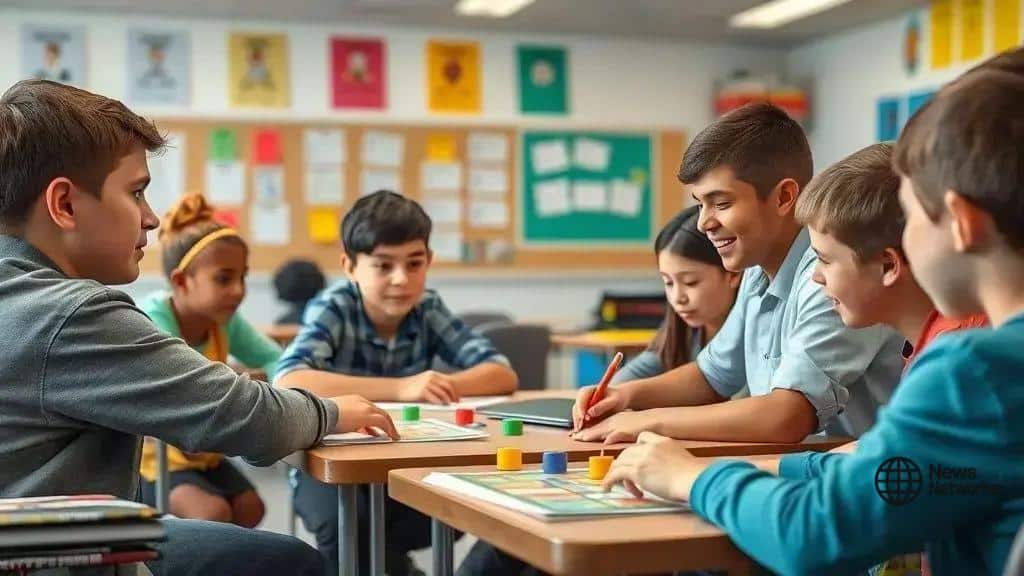Gamification in education: boosting engagement and retention

Gamification in education enhances student engagement and retention by incorporating game-like elements, fostering motivation, collaboration, and personalized learning experiences.
Gamification in education is transforming the way students engage with learning materials. By incorporating game-like elements, educators can make learning more enjoyable and effective. Have you ever wondered how a few playful changes could significantly enhance learning outcomes?
Understanding gamification in education
Understanding gamification in education is crucial for engaging students in the learning process. This approach merges game elements with traditional teaching strategies, making lessons more interactive and enjoyable. By infusing elements of play, educators can significantly improve student motivation and retention.
What is gamification?
Gamification involves using game-like features in non-game contexts. In education, this means incorporating points, badges, or challenges to create a game-like atmosphere. Students are more likely to participate when they view learning as a fun challenge rather than a chore.
Benefits of gamification
- Increased Engagement: Students are more enthusiastic about their lessons.
- Enhanced Motivation: Game mechanics can inspire students to strive for better performance.
- Improved Retention: Learning through games can help students remember information longer.
- Immediate Feedback: Gamification provides instant feedback, helping students see their progress.
Using gamification strategies, educators can transform regular assignments into competitive challenges. Imagine students working towards a leaderboard position rather than just completing an assignment. This competition motivates them to perform better and fosters a sense of community.
Furthermore, gamification can address diverse learning styles. For instance, visual learners may be drawn to interactive dashboards, while kinesthetic learners engage more with physical games. This versatility makes learning accessible to everyone.
In conclusion, gamification in education offers remarkable opportunities for enhancing student participation and effectiveness in learning. By integrating fun elements and competition into lessons, educators create a dynamic environment that encourages exploration and achievement.
Benefits of gamification for students
Benefits of gamification for students have gained significant attention as educators seek innovative ways to engage their classrooms. Gamification introduces game elements into learning, which can create exciting experiences for students. These strategies encourage participation and often lead to deeper understanding.
Enhanced Motivation
One key benefit of gamification is the increase in student motivation. When learning feels like a game, students are more likely to put forth effort. They become excited about competing for rewards, whether it’s points, badges, or recognition. This competitive spirit can transform the education environment.
Improved Engagement
- Interactive Learning: Gamified lessons often involve hands-on activities.
- Collaboration: Students can work together, enhancing teamwork skills.
- Problem Solving: Engaging games challenge students to think critically.
- Active Participation: Games encourage all students to participate, reducing boredom.
When students are actively engaged, they are more likely to absorb information. Gamified lessons often require students to interact with the material actively. By participating in a game, they are not just passive receivers of information; they are making choices and solving problems.
Furthermore, gamification provides immediate feedback. Students can see their progress in real-time, allowing them to identify areas for improvement quickly. This instant gratification can help boost their confidence and encourage a growth mindset.
This method also allows for personalized learning experiences. Students can progress at their own pace, which is crucial for catering to different learning styles. Through gamification, some students may excel while others develop skills they struggled with before, making education more inclusive.
Designing effective gamified learning experiences

Designing effective gamified learning experiences is essential to maximize the benefits of gamification in education. The goal is to create engaging activities that motivate students to learn while having fun. Properly designed experiences captivate students’ attention and encourage their participation.
Understanding the Key Elements
To create engaging gamified learning experiences, educators should start by understanding the essential elements of gamification. These include challenges, rewards, and feedback. Each of these components plays a critical role in keeping students interested.
Creating Challenges
- Relevant Tasks: Ensure that challenges relate directly to the lesson’s objectives.
- Varied Difficulty: Different levels of challenges cater to diverse skill sets.
- Time Limits: Adding time constraints can increase excitement.
- Problem Solving: Include scenarios that require critical thinking.
Challenges should be designed to stimulate curiosity and problem-solving. By crafting tasks that resonate with students, educators can create a more meaningful learning environment. When students face challenges that are appropriately difficult, they experience a sense of accomplishment upon overcoming them.
Additionally, providing rewards reinforces positive behavior and enhances motivation. Rewards can include points, virtual badges, or leaderboards. These elements foster friendly competition, encouraging students to strive for success. Elevating the learning experience through rewards makes it more enjoyable for students.
Feedback is another critical aspect of designing gamified experiences. Timely and constructive feedback helps students understand their performance and areas for improvement. This interaction encourages a growth mindset, allowing learners to develop confidence and resilience as they progress.
Ultimately, when designing gamified learning experiences, it is vital to consider the students’ perspectives and preferences. Integrating their feedback into the design process can lead to more impactful learning experiences, as students are more likely to engage in activities that they find enjoyable and relevant.
Challenges in implementing gamification
Challenges in implementing gamification in education can create hurdles for educators and institutions aiming to enhance student engagement. While gamification offers many benefits, it requires careful consideration to avoid potential pitfalls.
Understanding Resistance to Change
One of the main challenges is the resistance to change from both educators and students. Some educators may be unfamiliar with gamification techniques and hesitant to adopt new methods. Similarly, students accustomed to traditional learning may not react positively to game-based approaches at first.
Resource Allocation
Another challenge is the allocation of resources. Implementing gamified learning experiences often requires additional materials, technology, and training. Schools may struggle to find the necessary funds or time to develop these initiatives effectively.
Potential for Inequality
- Diverse Learning Styles: Not all students engage with gamification in the same way.
- Access to Technology: Students with limited access to technology may be left behind.
- Varied Interests: Some students may not enjoy or be motivated by game elements.
As with any educational strategy, ensuring that all students benefit equally from gamified experiences is crucial. Educators must consider diverse learning styles and interests to create inclusive gamified activities.
Furthermore, maintaining a balance between fun and learning can be tricky. Overemphasis on competition or rewards may lead some students to focus solely on winning rather than internalizing the educational content.
It is also essential to monitor student progress and adjust gamification strategies as needed. If not continually refined, these methods can become stale and lose their effectiveness. Continuous assessment of both student engagement and learning outcomes is vital to maintaining a successful gamified curriculum.
Future trends in educational gamification
Future trends in educational gamification are shaping the way teachers and learners approach education. As technology evolves, so do the methods and strategies used in gamified learning environments. Keeping an eye on these trends can help educators prepare for changes and embrace innovative practices.
Increased Use of Technology
The future will see an increasing integration of technology in gamified learning. Virtual and augmented reality (VR and AR) can create immersive experiences that not only captivate students but also enhance their understanding through real-world simulations.
Personalized Learning Experiences
Personalization is becoming a key focus in education. Gamification allows for tailored learning paths. Students can progress through levels at their own pace, making education more relevant to their interests and abilities. This individualized approach fosters greater engagement.
Social Learning Opportunities
- Collaborative Games: Group activities that encourage teamwork.
- Peer Feedback: Students learning from one another.
- Community Challenges: Engaging with external community goals.
- Global Collaboration: Working with students from around the world.
In the future, social aspects of learning will likely be emphasized more through gamification. Engaging students in collaborative games not only builds teamwork but also connects them with peers in their local community and around the globe. This interaction can enhance the educational experience and create lifelong friendships.
Additionally, gamification is expected to encompass a wider variety of game types and experiences. From role-playing games to simulation-based learning, educators will have numerous tools to engage students. As these options expand, so will the opportunities for creativity in lesson design.
Moreover, educators will increasingly rely on data analytics to track student progress. This data-driven approach can inform instructional strategies and allow for timely interventions. By harnessing insights from game performance, teachers can adjust their methods to better support each learner’s journey.
gamification in education holds great promise for enhancing student engagement and learning outcomes. By incorporating game elements, educators can make learning more interactive and enjoyable. Overcoming challenges in implementation and embracing future trends will further improve this dynamic teaching approach, creating a supportive environment where students thrive and become motivated learners. As technology advances, the potential for gamified experiences in education will continue to expand, paving the way for innovative teaching methods and a more engaging classroom atmosphere.
FAQ – Frequently Asked Questions about Gamification in Education
What is gamification in education?
Gamification in education involves using game elements like points, badges, and challenges to enhance student engagement and learning.
How does gamification benefit students?
It increases motivation, fosters collaboration, and helps students retain information through interactive and enjoyable learning experiences.
What challenges might educators face when implementing gamification?
Educators may encounter resistance to change, resource allocation issues, and the potential for inequality among students.
What are some future trends in gamification?
Future trends include increased use of technology, personalized learning experiences, and a greater emphasis on collaborative learning opportunities.





